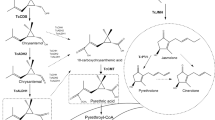Abstract
Knowledge of the value of pyrethrum flowers as an insecticidal material was kept well hidden by the original discoverers and it was not until the nineteenth century that European populations became aware of the disinfesting value of a material known as „Persian Insect Powder“. There is a widely accepted legend which tells that an Armenian merchant named Djumtikov obtained the secret from tribesmen when journeying in the Caucasus Mountains and the story ends with a belief that it was Djumtikov’s son who first began manufacture on a commercial scale. Gnadinger (1936) quotes another story which relates that a German woman of Dubrovnik in Dalmatia threw away a withered bunch of pyrethrum flowers which had served as a floral decoration. At a later date, this woman observed that these were surrounded by dead insects, a fact she wisely related to some specific property of the flowers themselves. Whether this story is true or not, it is a fact that the commercial development of pyrethrum originated in Dalmatia.
Preview
Unable to display preview. Download preview PDF.
Similar content being viewed by others
References
Association of Official Agricultural Chemists: Methods of Analysis, 5th ed, Washington, p. 66, 1940; 6th ed. p. 76, 1945; 7th ed. p. 72, 1950.
Beckley, V. A.: Pyrethrum Post 1, (3), 5 (1949); 2, (1), 23 (1950). — Beckley, V. A., C.B. Gnadinger and F. Ireland: Industr. Engng. Chem. (Industr.) 30, 835 (1938). — Beckley, V. A., and F. Mc Naughton: E. Afr. Agric. J. 2, 327 (1937). — Bray, G. T., S. H. Harper, K. A. Lord, F. Major and F. H. Tresadern: J. Soc. Chem. Ind. (Lond.) 66,275 (1947). — British Pharmaceutical Codex: London, Pharm. Soc. of Great Britain, p. 741, 1949. — Brown, N. C., R. F. Phipers and K. G. Singleton: ( In press ) 1954.
Campbell, A., and W. Mitchell: J. Sci. Food Agric. 1, 137 (1950). — Colonial Products Advisory Bureau (Plant and Animal).-Report of the Standing Sub-Committee on Methods of Analysis of Vegetable Insecticides on the World-wide Collaborative Analysis of Pyrethrum Flowers, 1948–1949. London: Colonial Office 1950. — Crombie, L., M. Elliott, S. H. Harper and H. W. B. Reed: Nature (London) 162, 222 (1948).
Fujitani, J.: Arch, exper. Path. u. Pharmakol. 61, 47 (1909).
Gerhardstein, S.: Quoted by Colonial Products Advisory Bureau, 1950. — Gersdorff, W. A.: J. Econ. Ent. 40, 878 (1949). — Gillam, A. E., and T. F. West: J. Chem. Soc. 1942, 671; J. Soc. Chem. Ind. (Lond.) 68, 23 (1944). — Gnadinger, C. B.: Pyrethrum Flowers: Suppl., 2nd ed. Minneapolis: McLaughlin Gormley King Co. 1945. — Gnadinger, C. B., and C. S. Corl: J. Amer. Chem. Soc. 51, 3054 (1929); 52, 680 (1930); Industr. Engng. Chem. (Industr.) 24, 901 (1932). — Graham, J. J. T., and F. B. La Forge: Soap, N. Y. 19, (11), 111 (1943). — Green, R. G., W. Pohl, F. H. Tresadern and T. F. West: J. Soc. Chem. Ind. (Lond.) 61, 173 (1942).
Harper, S. H.: J. Chem. Soc. 1946,892; Pyrethrum Post 1, (3) 9 (1949); (4), 10 (1949). — Holaday, D. A.: Industr. Engng. Chem. (Anal.) 10, 5 (1938).
Kelsey, D.: J. Assoc. Off. Agric. Chem. Wash. 35, 368 (1952); 86, 369 (1953).
La Forge, F. B., and W. F. Barthel: J. Org. Chem. 9, 242 (1944); 10,106,114 (1945). — La Forge, F. B., and N. Green: J. Org. Chem. 17, 1635 (1952). — La Forge, F. B., and H. L. Haller: J. Amer. Chem. Soc. 58,1777 (1936). — La Forge, F. B., and S. B. Soloway: J. Amer. Chem. Soc. 69, 186, 2932 (1947). — Lord, K. A., J. Ward, J. A. Cornelius and M. W. Jarvis: J. Sci. Food Agric. 8, 419 (1952).
Martin, J. T., and S. T. P. Brightwell: J. Soc. Chem. Ind. (Lond.) 65, 379 (1946). — Martin, J. T., and F. Tattersfield: Ann. Appl;. Biol. 21, 670, 682 (1934). — Mitchell, W.: Pyrethrum Post 1, (3), 7 (1949);(1) J. Sci. Food. Agric. 4, 246 (1953); (2) 4, 278 (1953). — Mitchell, W., and P. F. Barker: J. Sci. Food . Agric. 4, 282 (1953). — Mitchell, W., and F. H. Tresadern: J. Soc. Chem. Ind. (Lond.) 68, 221 (1949). — Mitchell, W., F. H. Tresadern and S. A. Wood: Analyst 73, 484 (1948).
Potter, C., and K. A. Lord: Pyrethrum Post 8, (1), 12 (1953).
Repert, J.: Ann. Falsif. Paris 27, 580 (1934); 28, 27 (1935).
Schechter, M. S., N. Green and F. B. La Forge: J. Amer. Chem. Soc. 71,3165 (1949). — Seil, H. A.: Soap, N. Y. 10, (5), 89 (1934); 23, (9), 131 (1947). — Shukis, A. J., D. Cristi and H. Wachs: Soap, N. Y. 27, (11), 124 (1951). — Staudinger, H., and H. Harder: Ann. Acad. Sci. fenn. 29, (18), 1 (1927). — Staudinger, H., and L. Ruzicka: Helv. Chim. Acta 7, 177, 201, 212, 236, 245, 377, 390, 406, 442, 448 (1924).
Tattersfield, F.: Ann. AppL. Biol. 18, 602 (1931). — Tattersfield, F., R. P. Hobson and C. T. Gimingham: J. Agric. Sci. 19, 266 (1929). — Textor, O.: Amer. J. Pharm. 53, 491 (1881).
Ward, J.: Chem. and Ind. (Rev.) 1953, 586. — World Health Organisation: Insecticides Manual of Specifications for Insecticides and for spraying and dusting Apparatus, Geneva 1953. — Wilcoxon, F.: Contr. Boyce Thompson Inst. 8, (3), 175 (1936).
Yamamoto, R.: J. Tokyo Chem. Soc. 40, 126 (1919); J. Chem. Soc. Japan 44, 311, 1070 (1923).
Editor information
Rights and permissions
Copyright information
© 1955 Springer-Verlag OHG.
About this chapter
Cite this chapter
Phipers, R.F. (1955). Pyrethrins and Allied Compounds. In: Paech, K., Tracey, M.V. (eds) Moderne Methoden der Pflanzenanalyse/Modern Methods of Plant Analysis. Moderne Methoden der Pflanzenanalyse/Modern Methods of Plant Analysis, vol 3. Springer, Berlin, Heidelberg. https://doi.org/10.1007/978-3-642-64958-5_2
Download citation
DOI: https://doi.org/10.1007/978-3-642-64958-5_2
Publisher Name: Springer, Berlin, Heidelberg
Print ISBN: 978-3-642-64960-8
Online ISBN: 978-3-642-64958-5
eBook Packages: Springer Book Archive




